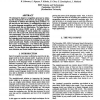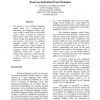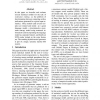NAACL
1994
14 years 1 months ago
1994
We attemped to improve recognition accuracy by reducing the inadequacies of the lexicon and language model. Specifically we address the following three problems: (1) the best size...
NAACL
1994
14 years 1 months ago
1994
In this paper, we propose a new stochastic language model that integrates local and global constraints effectively and describe a speechrecognition system basedon it. Theproposedl...
ANLP
1994
14 years 1 months ago
1994
Many of the kinds of language model used in speech understanding suffer from imperfect modeling of intra-sentential contextual influences. I argue that this problem can be address...
ACL
1997
14 years 1 months ago
1997
To understand a speaker’s turn of a conversation, one needs to segment it into intonational phrases, clean up any speech repairs that might have occurred, and identify discourse...
AAAI
1997
14 years 1 months ago
1997
We describe a parsing system based upon a language model for English that is, in turn, based upon assigning probabilities to possible parses for a sentence. This model is used in ...
COLING
2000
14 years 1 months ago
2000
We present a new statistical language model based on a Colnbination of individual word language models. Each word model is built from an individual corpus which is formed by extra...
NIPS
2004
14 years 1 months ago
2004
Statistical language models estimate the probability of a word occurring in a given context. The most common language models rely on a discrete enumeration of predictive contexts ...
CLIN
2001
14 years 1 months ago
2001
Two major stages stages in language identification systems can be identified: the language modeling stage, where the distinctive features of languages are determined and stored in...
EMNLP
2006
14 years 1 months ago
2006
In this paper we describe and evaluate several statistical models for the task of realization ranking, i.e. the problem of discriminating between competing surface realizations ge...
ECIR
2006
Springer
14 years 1 months ago
2006
Springer
Genomic IR, characterized by its highly specific information need, severe synonym and polysemy problem, long term name and rapid growing literature size, is challenging IR communit...





